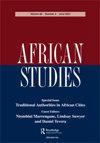Urbanisation and the water challenge in Africa: Mapping out orders of water scarcity
IF 1
4区 社会学
Q2 AREA STUDIES
引用次数: 9
Abstract
ABSTRACT Water scarcity has featured prominently in the policy discourses, especially at the United Nations level. This is in response to the growing pressure exerted on water resources by the rising global population against renewable but finite water resources. This challenge is acutely manifested in low income countries in Africa, where the rate at which the urban population is growing has outstripped the capacity of water services providers to accommodate all residents at an adequate and sustainable level. However, the dominant discourse on water scarcity has focused on the deteriorating water availability in the natural environment, paying less attention to other forms of scarcity, particularly the socially induced ones. This article takes a broader approach to the concept of water scarcity to mapout the different orders of water scarcity. By categorising scarcity into four different types (orders), it illustrates that while first order scarcity is a result of natural lack of water, the other three orders of scarcity are human and socially induced. This approach highlights the need for a more nuanced understanding of water scarcity to enable effective planning for water resource use and service management. By highlighting the different dimensions of water scarcity, the article aims to make a contribution to the debates on sustainable management and use of water resources.非洲的城市化和水资源挑战:绘制缺水顺序
摘要:缺水问题在政策讨论中占有突出地位,尤其是在联合国一级。这是为了应对日益增长的全球人口对可再生但有限的水资源施加的越来越大的水资源压力。这一挑战在非洲低收入国家表现得尤为突出,这些国家的城市人口增长速度已经超过了供水服务提供商在适当和可持续水平上容纳所有居民的能力。然而,关于水资源短缺的主要讨论集中在自然环境中日益恶化的水资源可用性上,而对其他形式的水资源短缺,特别是社会引发的水资源稀缺,关注较少。本文对缺水的概念进行了更广泛的研究,以绘制出不同的缺水顺序。通过将稀缺性分为四种不同的类型(阶),它表明,虽然一阶稀缺性是自然缺水的结果,但其他三阶稀缺性则是人类和社会造成的。这种方法强调需要对缺水问题有更细致的理解,以便能够有效规划水资源的使用和服务管理。通过强调水资源短缺的不同层面,本文旨在为关于水资源可持续管理和利用的辩论做出贡献。
本文章由计算机程序翻译,如有差异,请以英文原文为准。
求助全文
约1分钟内获得全文
求助全文

 求助内容:
求助内容: 应助结果提醒方式:
应助结果提醒方式:


